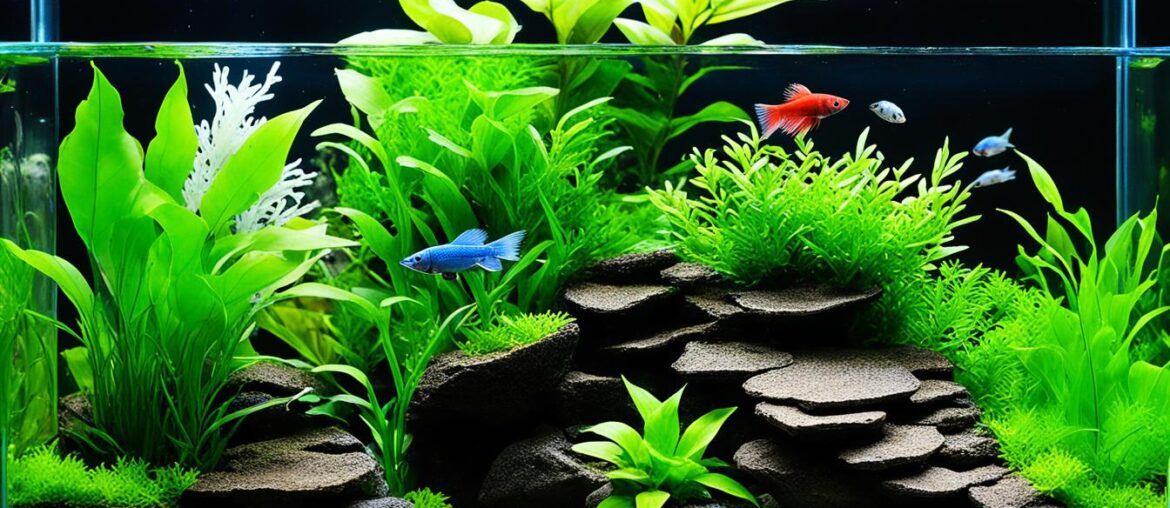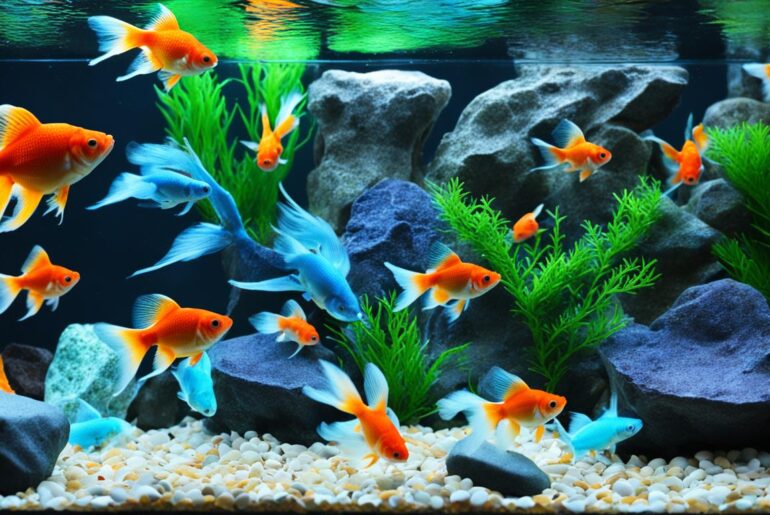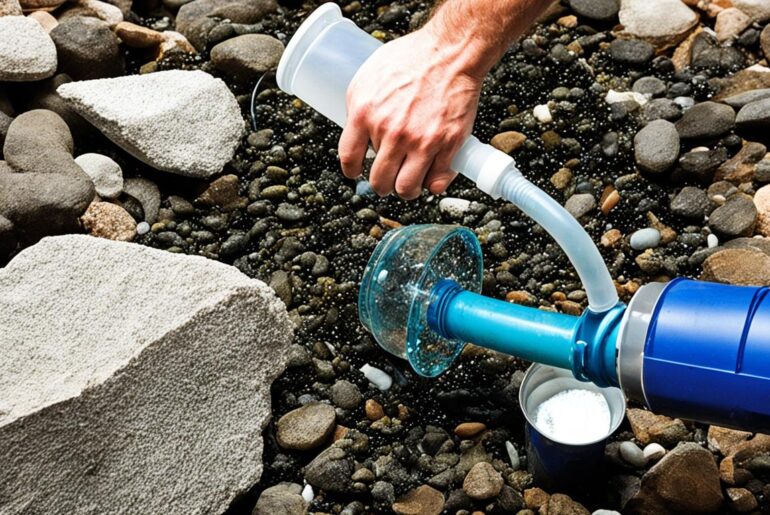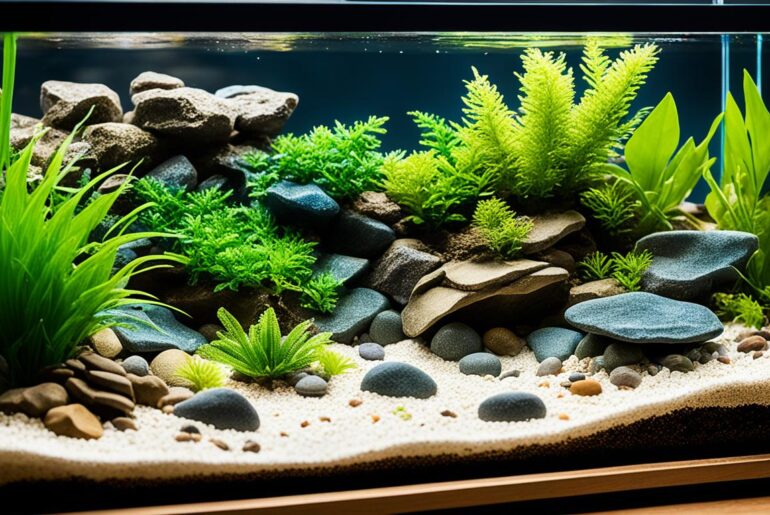Do you ever find yourself gazing at the beautiful colors and graceful movements of your betta fish, feeling a sense of awe and wonder? I know I do. There’s something truly magical about these captivating creatures, with their flowing fins and vibrant personalities. As a betta enthusiast, I’ve always strived to create the best possible environment for my finned friends, one that allows them to thrive and display their true beauty.
One aspect that often goes overlooked when setting up a betta tank is the choice of substrate. While betta fish can certainly survive without it, there are numerous benefits to using the right substrate in their tank. Not only does it provide a natural and comfortable environment for these fish, but it also supports the growth of plants and provides a surface area for beneficial bacteria to thrive.
When it comes to selecting the best substrate for your freshwater betta tank, there are several options to consider. From Aqua Soil to Sand, Gravel, and Rocks, each choice has its own advantages and disadvantages. The key is to find the substrate that aligns with your goals, whether it be creating an aquascape masterpiece or simply providing a safe and healthy home for your betta.
Key Takeaways:
- Choosing the right substrate for your betta tank can enhance the overall beauty and health of your fish.
- Substrate provides a natural and comfortable environment for betta fish, supports plant growth, and promotes the growth of beneficial bacteria.
- Consider factors such as the type of plants you want to keep, the aesthetics you desire, and the maintenance requirements when selecting a substrate.
- Aqua Soil, Sand, Gravel, and Rocks are popular choices for betta tank substrates, each with its own pros and cons.
- The best substrate choice will depend on your specific goals and the needs of your betta tank setup.
Do Betta Fish Need Substrate?
Technically, Betta fish don’t need substrate in their tank. Some aquarists have successfully kept Betta tanks without substrate. However, substrate provides several benefits that can contribute to a healthier and more vibrant tank environment.
One of the primary advantages of using substrate is its ability to support the growth of plants with root systems. Substrate provides a stable and nutrient-rich foundation for plants, allowing them to anchor themselves securely and absorb essential nutrients from the substrate. This results in healthier and more robust plant growth, creating a lush and natural habitat for Betta fish.
In addition, the presence of substrate can help reduce the visibility of dirt and debris in the tank. The substrate acts as a barrier, trapping particles and preventing them from floating around the tank. This not only keeps the tank looking cleaner and more aesthetically pleasing but also contributes to better water quality by reducing the accumulation of debris.
Substrate also plays a crucial role in providing surface area for beneficial bacteria to thrive. These bacteria help break down harmful toxins, such as ammonia and nitrite, into less harmful substances. The larger the surface area provided by the substrate, the more beneficial bacteria can colonize the tank, leading to improved water quality and a healthier environment for Betta fish.
Lastly, having substrate in a Betta tank enhances the overall visual appeal. It adds depth, texture, and natural beauty to the tank, creating a more visually captivating and engaging environment. Whether you prefer a sandy beach-like substrate or a gravel bed adorned with rocks and plants, substrate can help create the aesthetic you desire.
While Betta fish can survive without substrate, it is highly recommended to introduce substrate into their tank. It promotes the growth of plants, reduces visible dirt and debris, provides surface area for beneficial bacteria, and enhances the overall visual appeal of the tank.
Benefits of Substrate for Betta Fish:
- Supports the growth of plants with root systems
- Reduces visibility of dirt and debris
- Provides surface area for beneficial bacteria
- Enhances the overall visual appeal of the tank
“Substrate provides a stable and nutrient-rich foundation for plants, allowing them to anchor themselves securely and absorb essential nutrients from the substrate.”
4 Best Types of Substrates for Betta Fish.
When it comes to selecting the perfect substrate for your Betta fish tank, there are several options to consider. The four best types of substrates for Betta fish tanks are Aqua Soil, Sand, Gravel, and Rocks. Each of these substrates offers unique benefits that can enhance the overall health and appearance of your tank.
Aqua Soil
Aqua Soil is a nutrient-rich substrate specifically designed for planted aquariums. This substrate is packed with essential nutrients and minerals that promote the healthy growth of live plants. It is an excellent choice for Betta tanks that have a planted setup. Aqua Soil not only provides the necessary nutrients for plant growth but also helps maintain optimal water parameters. It has the added benefits of water softening and pH level regulation, creating a favorable environment for your Betta fish to thrive.
Sand
Sand is a popular substrate choice among Betta fish owners for several reasons. Firstly, it is gentle on the delicate fins of Betta fish, providing a comfortable environment for them to navigate. Secondly, sand is easy to clean using a siphon vacuum cleaner, making maintenance a breeze. Additionally, sand offers a natural look and feel to your tank, mimicking the riverbeds where Betta fish naturally reside.
Gravel
Gravel is a cost-effective substrate option that provides various benefits for Betta fish tanks. It offers a surface area for beneficial bacteria to colonize, aiding in the biological filtration of the tank. Gravel also allows for proper anchoring of aquatic plants, ensuring they stay in place as they grow. With a wide range of colors and sizes available, gravel allows you to create a visually appealing tank that suits your personal aesthetic preferences.
Rocks
Rocks can be used as a substrate option in Betta fish tanks to add a natural and decorative element. They can serve as a base for plants and decorations, creating an aesthetically pleasing setup. Before adding rocks to your tank, ensure they do not have sharp edges that could potentially harm your Betta fish. Choosing smooth rocks will prevent any injuries and maintain the overall well-being of your fish.
When deciding on the best substrate for your Betta fish tank, consider factors such as the presence of live plants, ease of maintenance, and the desired visual appeal. Each substrate type has its own advantages and considerations. Now that you’re familiar with the four best types of substrates for Betta fish tanks, you can make an informed decision to create a thriving and beautiful habitat for your Betta fish.
| Substrate Type | Benefits |
|---|---|
| Aqua Soil | Rich in nutrients Supports plant growth Water softening properties Regulates pH levels |
| Sand | Gentle on fins Easy to clean Natural look and feel |
| Gravel | Cost-effective Provides surface area for beneficial bacteria Allows proper plant anchoring |
| Rocks | Adds a natural and decorative element Can be used as a base for plants and decorations |
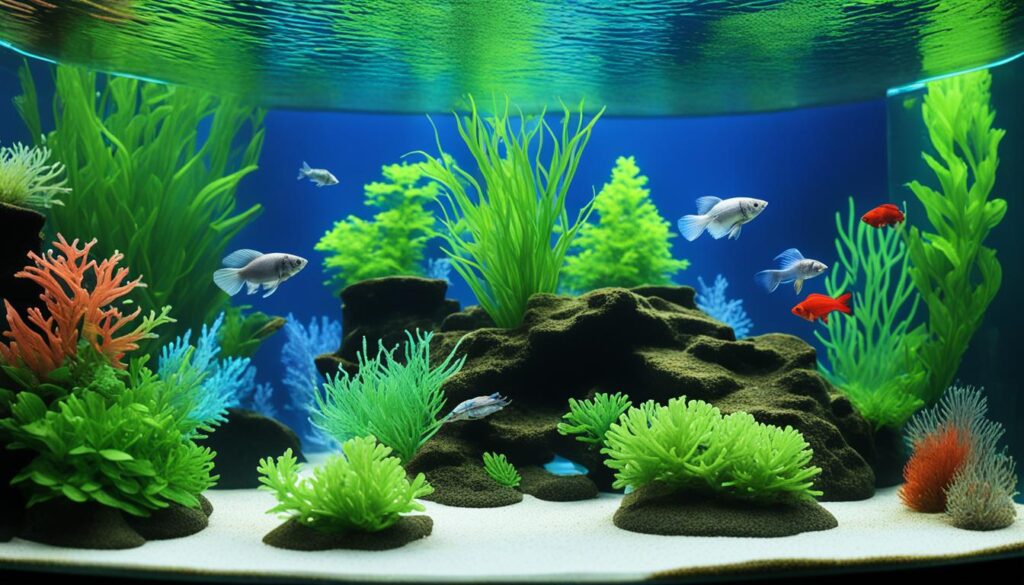
Aqua Soil – Pros and Cons.
When it comes to creating a lush and thriving planted aquarium for your Betta fish, Aqua Soil is a fantastic substrate choice. This specially designed substrate is packed with essential nutrients and minerals that promote the growth of live plants, creating a stunning and natural aquatic environment.
One of the biggest advantages of Aqua Soil is its suitability for planted tanks. The nutrient-rich composition provides plants with the necessary elements they need to flourish, resulting in vibrant and healthy growth. Aqua Soil also helps to maintain optimal water parameters, creating a stable and balanced tank environment for your Betta fish.
Table: Aqua Soil – Pros and Cons
| Pros | Cons |
|---|---|
| Aqua Soil is perfect for planted tanks, promoting lush plant growth | It can be more expensive compared to other substrate options |
| Longevity – Aqua Soil can last for several years before needing replacement | It initially leaches ammonia, which may require careful monitoring during tank cycling |
| Additional benefits include the presence of beneficial bacteria that aid in overall tank health | Requires a fully cycled tank for safe use |
Aqua Soil not only provides an abundant source of nutrients but also contains beneficial bacteria that contribute to a healthy aquatic ecosystem. These bacteria aid in the breakdown of waste and help maintain water quality, reducing the risk of harmful ammonia spikes.
While Aqua Soil offers many advantages for planted Betta tanks, it is important to consider the potential drawbacks. One consideration is the cost, as Aqua Soil can be more expensive compared to other substrate options. However, its longevity and the benefits it provides for plant growth and water parameters make it a worthwhile investment for serious hobbyists.
Another factor to keep in mind is the initial leaching of ammonia that Aqua Soil can undergo. This natural process can be managed by carefully monitoring and controlling ammonia levels during the tank cycling phase. Once the tank is fully cycled, Aqua Soil will continue to provide the necessary nutrients and create an optimal environment for both your Betta fish and plants.
In conclusion, Aqua Soil offers an excellent substrate option for Betta tanks that are planted. Its nutrient-rich composition, longevity, and additional benefits such as beneficial bacteria make it a popular choice among aquarists. While it may come with a higher price tag and require careful monitoring during tank cycling, the rewards of a lush and thriving aquarium make Aqua Soil a worthwhile investment.
Sand – Pros and Cons.
Sand is a popular substrate choice for Betta tanks due to its natural appearance and fish-friendly qualities. It provides a soft and gentle surface that is easy on betta fish’s delicate fins. Unlike gravel, sand does not shift as much, making it easier to maintain a clean and tidy tank.
However, it is important to note that sand requires proper maintenance to prevent issues like anaerobic pockets and compaction. Regular stirring and maintenance are necessary to ensure the substrate remains healthy for your betta fish and the overall tank ecosystem.
Another consideration with sand is its potential to decrease pH levels over time. This can have an impact on the water chemistry and may require additional adjustments to maintain the optimal pH range for your betta fish.
Additionally, sand may not be the best substrate choice if you plan to have live plants in your Betta tank. The fine texture of sand can hinder proper root system growth for plants. If live plants are a priority, other substrate options like Aqua Soil or gravel may be more suitable.
When choosing sand for your Betta tank, there are several recommended options available. Seachem Fluorite Black Sand, Carib Sea Super Naturals, and ADA AquaNatural Diamond Black are popular choices known for their quality and compatibility with Betta fish. These sands provide a natural look and feel while maintaining the health and well-being of your Betta.
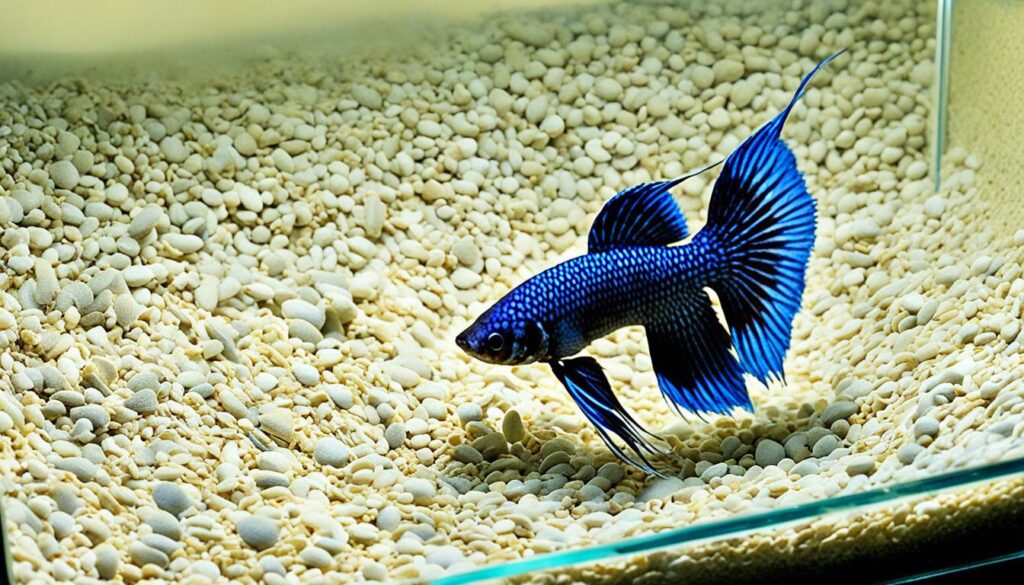
| Pros | Cons |
|---|---|
| Gentle on betta fish’s fins | Requires regular maintenance |
| Natural and aesthetic look | May decrease pH levels |
| Easier to maintain a clean tank | May hinder root system growth for live plants |
Gravel – Pros and Cons.
Gravel is a popular choice for Betta tank substrate due to its cost-effectiveness and its ability to support beneficial bacteria growth and plant development. It comes in various sizes and is readily available at local fish stores, making it a convenient option for aquarium enthusiasts.
When choosing gravel for a Betta tank, it is important to select smoother variants to prevent any damage to the delicate fins of the fish. Rough gravel can cause tearing or snagging, leading to potential health issues for the Betta.
One recommended gravel substrate for Betta tanks is Seachem Flourite Gravel. This type of gravel is specially designed for planted aquariums and provides essential nutrients for plant growth, creating a thriving and visually appealing tank environment for both the Betta and the plants.
Additionally, Pisces Gunsmoke Aquarium Gravel is another option to consider. It offers a natural aesthetic and can complement the overall design of the tank. This gravel substrate also provides a surface area for beneficial bacteria colonization, which helps maintain a healthy and balanced ecosystem within the tank.
Gravel substrates offer the following advantages and disadvantages:
| Pros | Cons |
|---|---|
| 1. Cost-effective option | 1. Careful selection required to avoid rough edges |
| 2. Provides surface area for beneficial bacteria growth | 2. Can accumulate debris between grains |
| 3. Allows for proper anchoring of live plants | 3. Requires occasional vacuuming to maintain cleanliness |
By carefully weighing the pros and cons, you can determine if gravel is the right substrate choice for your Betta tank. Remember to choose a smooth variant, such as Seachem Flourite Gravel or Pisces Gunsmoke Aquarium Gravel, to ensure your Betta’s comfort and well-being.
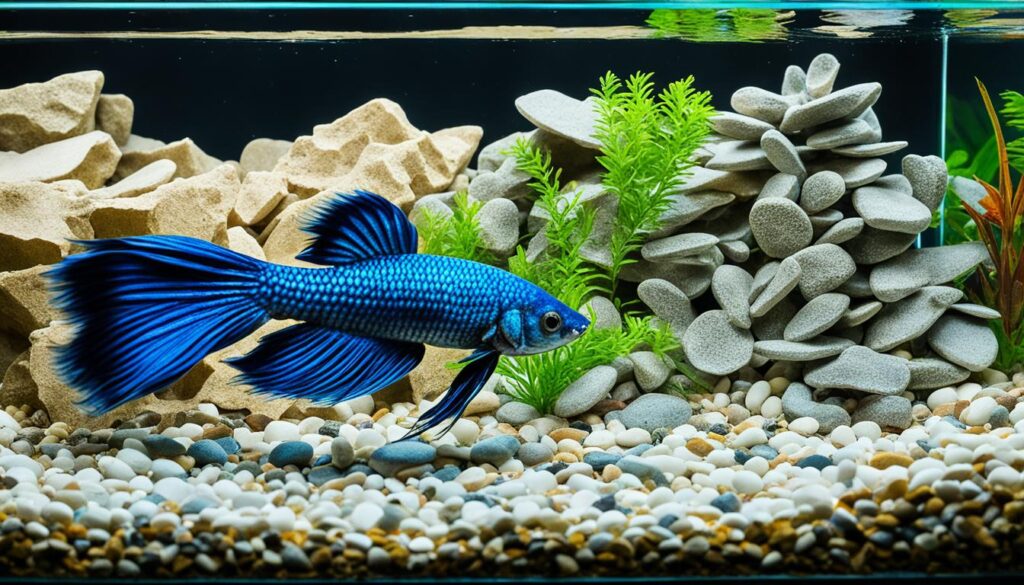
Rocks – Pros and Cons.
Rocks can be a versatile and visually appealing substrate choice for Betta tanks. They can add a natural and decorative element to the tank setup, creating a harmonious and aesthetically pleasing environment. Here are the pros and cons of using rocks as a substrate for Betta tanks:
Pros:
- Rocks can serve as a sturdy base for plants and decorations, allowing you to create unique aquascapes and provide hiding spots for your Betta fish.
- They come in various shapes and sizes, giving you the flexibility to create different textures and designs in your tank.
- Using rocks as a substrate can help anchor plants, preventing them from floating or uprooting.
- Rocks provide surfaces for beneficial bacteria to colonize, aiding in biological filtration and maintaining water quality.
Cons:
- It is crucial to select rocks that do not have sharp edges or rough surfaces, as they can potentially harm Betta fish’s delicate fins.
- Care should be taken when choosing rocks to avoid those that may leach minerals or substances that can alter water chemistry.
- Rocks can be more challenging to clean compared to other substrates, as debris can get trapped between the crevices.
- The weight and density of rocks may make them less suitable for planted tanks or for betta fish that prefer open swimming areas.
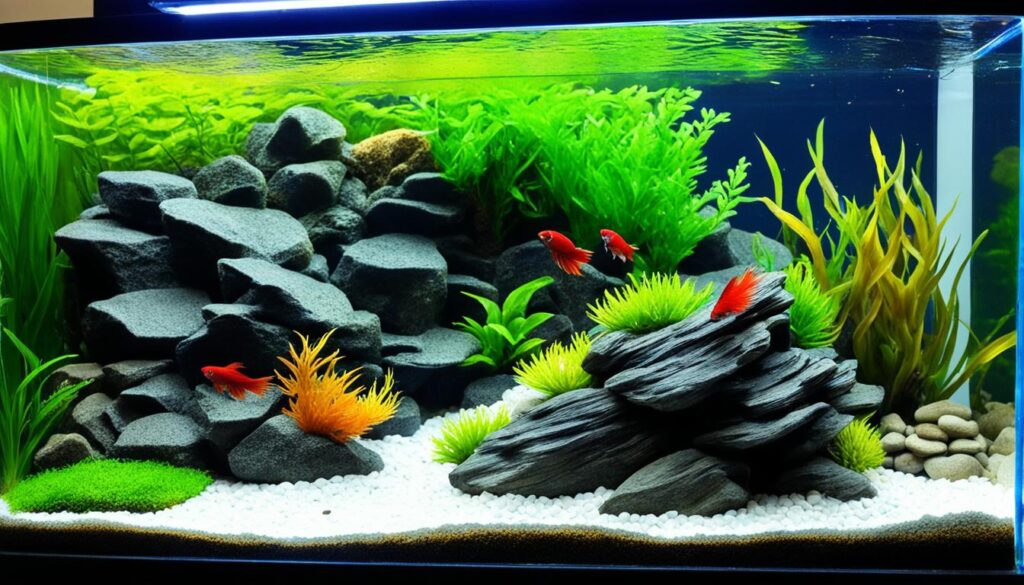
| Pros | Cons |
|---|---|
| Rocks can serve as a base for plants and decorations. | Selecting rocks with sharp edges can harm Betta fish. |
| They come in various shapes and sizes, allowing for creative aquascapes. | Rocks may leach minerals or substances that can alter water chemistry. |
| Rocks provide surfaces for beneficial bacteria to colonize. | Can be more challenging to clean compared to other substrates. |
| Can be used to create hiding spots for Betta fish. | May not be suitable for planted tanks or betta fish that prefer open swimming areas. |
Other Substrate Options.
In addition to Aqua Soil, Sand, Gravel, and Rocks, there are other substrate options that can be used in Betta tanks. Let’s explore two of these options:
Marbles
Marbles are a suitable choice for smaller Betta tanks and bowls. They are easy to clean during water changes and provide a decorative element that can enhance the visual appeal of the tank. Marbles come in various colors and sizes, allowing for creative and personalized tank designs.
“Adding marbles to my Betta tank was a game-changer. It not only made cleaning a breeze, but also added a touch of elegance to the overall aesthetic.” – Betta enthusiast
Bare Bottom Tanks
Bare bottom tanks are another option for Betta fish owners. These tanks eliminate the need for substrate, making cleaning and maintenance easier. The absence of substrate also ensures that no debris or waste gets trapped, promoting a cleaner and healthier environment. However, it’s important to note that bare bottom tanks do not provide any surface area for beneficial bacteria to colonize, and plants cannot be anchored in this type of setup.
To help you compare the available substrate options, here is a table highlighting their main characteristics:
| Substrate | Advantages | Disadvantages |
|---|---|---|
| Aqua Soil | – Nutrient-rich for plant growth – Supports water softening and pH regulation – Beneficial bacteria |
– Expensive – Ammonia leaching initially – Requires a fully cycled tank |
| Sand | – Natural look and feel – Gentle on betta fish’s fins – Easy to clean |
– Requires regular stirring – May decrease pH levels over time – Limitations for root system growth |
| Gravel | – Cost-effective – Provides surface area for beneficial bacteria – Suitable for proper plant anchoring |
– Careful selection to avoid fin damage – More debris accumulation compared to sand |
| Rocks | – Adds natural and decorative element – Can be used as a base for plants and decorations |
– Sharp edges can harm betta fish’s fins – Requires careful arrangement |
| Marbles | – Easy to clean – Decorative element – Various colors and sizes |
– No surface area for beneficial bacteria – No plant anchoring capability |
| Bare Bottom Tanks | – Easy cleaning and maintenance – No debris or waste buildup |
– No surface area for beneficial bacteria – No plant anchoring capability |
As you can see, each substrate option has its own advantages and disadvantages. The choice will ultimately depend on your personal preference, tank size, desired aesthetics, and specific requirements of your Betta fish setup. Consider the needs of your fish and the overall visual appeal you want to achieve in order to make the best substrate decision.
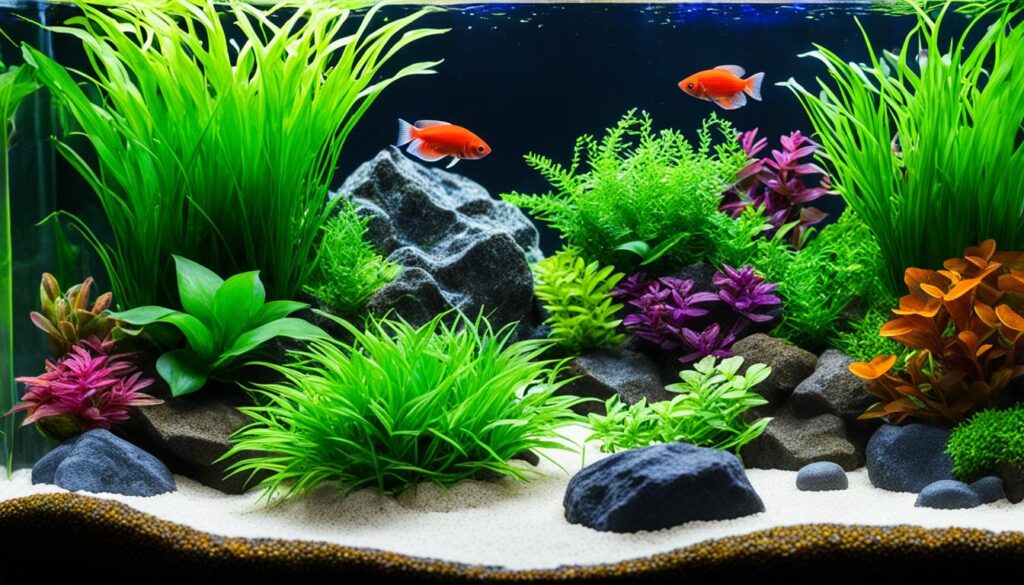
Conclusion.
After considering all the factors, selecting the best substrate for a freshwater Betta tank is crucial in creating a healthy and vibrant environment for these beautiful fish. Aqua Soil, Sand, Gravel, and Rocks are the most popular substrate choices, each offering its own advantages and disadvantages.
When making a decision, it is important to think about the type of plants you want to keep, the desired aesthetics, and the maintenance requirements. Aqua Soil is a great choice for planted tanks, while sand provides a natural look and is gentle on betta fish’s fins. Gravel is cost-effective and supports beneficial bacteria, and rocks add a decorative touch to the tank.
Ultimately, the substrate choice should be based on providing an optimal environment for the well-being of Betta fish and enhancing the overall beauty of the tank. By carefully considering these factors, you can create a Betta tank that not only ensures the health and happiness of your fish but also becomes a stunning centerpiece in your home or office.
FAQ
Do Betta fish need substrate in their tank?
Technically, Betta fish don’t need substrate in their tank. However, using substrate provides several benefits such as allowing for the growth of plants, reducing visible dirt and debris, and providing surface area for beneficial bacteria to thrive.
What are the best types of substrates for Betta fish?
The four best types of substrates for Betta fish are Aqua Soil, Sand, Gravel, and Rocks.
What are the pros and cons of Aqua Soil?
Aqua Soil is a nutrient-rich substrate that is great for planted tanks and provides additional benefits such as water softening and maintaining optimal pH levels. However, it can be more expensive compared to other substrates, leach ammonia initially, and requires a fully cycled tank for safety.
What are the pros and cons of Sand?
Sand is a popular choice for Betta tanks because of its natural look, gentle texture, and ease of cleaning. However, sand requires proper maintenance, such as regular stirring to prevent anaerobic pockets and compaction. It may also decrease pH levels over time and may prevent proper root system growth for plants.
What are the pros and cons of Gravel?
Gravel is a cost-effective substrate choice that supports beneficial bacteria and plant growth. It also comes in various sizes and is widely available. However, it is important to choose smoother variants of gravel to avoid damaging betta fish’s fins.
What are the pros and cons of Rocks?
Rocks can add a natural and decorative element to Betta tanks. They can be used as a base for plants and decorations or as hiding spots for betta fish. However, it is important to ensure that the rocks do not have sharp edges that can harm the betta fish’s delicate fins.
What are some other substrate options for Betta tanks?
Some other substrate options for Betta tanks include marbles, which are suitable for smaller tanks and bowls, and bare bottoms, which eliminate the need for substrate but do not provide surface area for beneficial bacteria.
How do I select the best substrate for my Betta tank?
When selecting the best substrate for your Betta tank, consider factors such as the type of plants you want to keep, the aesthetics you desire, and the maintenance requirements. This will help you make an informed decision that promotes a healthy and vibrant environment for your Betta fish.
